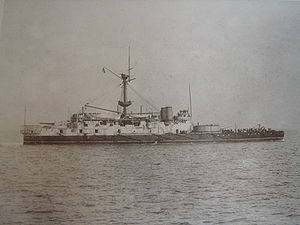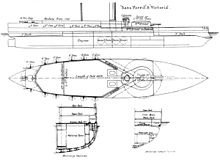Victoria class (battleship)

|
|
|---|---|
|
|
|
| Displacement: | 11,020 tons (11,200 t) |
| Length: | 100 m |
| Width: | 21.0 m |
| Draft: | 8.8 m |
| Drive: |
|
| Speed: | 16.75 kn (approx. 31 km / h) |
| Crew: | 630 |
| Armament: | Guns:
Torpedo tubes:
|
| Armor: | Belt armor 457 mm |
The Victoria class was a class of battleships in the Royal Navy . The two ships of this class were laid down in 1885 and put into service in 1890 and 1891 respectively. The HMS Victoria sank in the Mediterranean after a collision with another Royal Navy warship. Her sister ship, the HMS Sans Pareil , remained in service until 1907 when it was scrapped. In the Victoria class, triple composite steam engines were used for the first time in British warship construction.
draft

The class was developed and built during the transition from broadside to tower ship . In the case of broadside ships that had the cannons set up across the direction of travel in a broadside, the whole ship had to be aimed roughly. Both in battles on land and at sea, however, a larger sweep angle and a higher target speed were required. This led to the concept of the tower ship. However, since various problems had to be solved both in the construction of the towers, such as armor protection, mountings, ammunition feed, and with the ship itself, a variety of designs were built during this transition period. In the Victoria class, some of the guns were installed in conventional battery setup, while the main armament was installed in a barette on a turntable mount . During the same period, the Royal Navy finally switched from the temporarily reintroduced muzzle loaders ( RML - Riffled Muzzle Loading) to breech loading ( BL - Breech Loading). With the development of the compound steam engine, it was possible to reduce the consumption of coal and increase the range. This made it possible to dispense with the sails. The Victoria class thus combines modern elements of shipbuilding (armored turret, drive, rear loader) with conventional elements (battery installation). It was overtaken by the rapidly advancing development.
The Victoria class emerged from the HMS Conqueror . The ships of this class were originally called the new Conquerors . The caliber of the main armament was to be increased from 12 inches (305 mm) to 13.5 inches (343 mm). Eventually, however, 16.25 inch (413 mm) caliber guns weighing 110 tons were provided. The shells on this gun weighed 1,800 lb (816 kg) and could penetrate any armor at the time. The cannon designed and built by Armstrong was delivered in a similar form to the Regia Marina Italiana and installed there in the battleship Andrea Doria . The cannon was also used on the last Admiral-class ship to be built, the HMS Benbow . These three ships were the only Royal Navy ships that carried this caliber. A similarly constructed 10 inch (254 mm) cannon was used in the stern turret.
At the time, the Royal Navy saw naval supremacy in the Mediterranean as one of its most important tasks. The ships of the Victoria class were therefore intended for use in the Mediterranean fleet.
history
Both ships were laid down in 1885 at Armstrong Whitworth and Thames Ironworks and Shipbuilding and Engineering Co. Ltd., Blackwall (London) and were launched in 1887. The commissioning took place in 1890/1891.
The ships were among the last battleships with a very low freeboard . It was only ten feet. The intention was to provide a smaller target for enemy ships. However, this had a negative impact on the seaworthiness. The low freeboard contributed significantly to the rapid sinking of the HMS Victoria .
The 16.25-inch cannon did not prove itself in use. The rate of fire for a shot was four to five minutes. The barrel had to be changed every 75 shots.
The most successful innovation was the introduction of the triple composite steam engine. The introduction of steel in boiler construction enabled higher operating pressures and thus a threefold expansion of the steam. In the Royal Navy, such a machine was first installed on the HMS Thunderer for test purposes and later used on the torpedo boat HMS Rattlesnake . Compared to conventional steam engines, the coal consumption could be almost halved. This enabled the water displacement to be reduced or stronger armament and armor to be installed.
Ships of the class
literature
- Stenzel, Alfred: The British Navy . T. Fisher Unwin, London 1898
- Brassey, Thomas Alnutt: Brassey's Naval Annual . J. Griffin & Co, Portsmouth 1902
- Jane, Fred T .: The British battle fleet; its inception and growth throughout the centuries to the present day . The Library Press, London 1915

